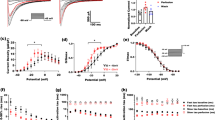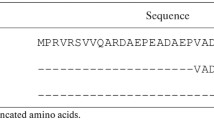Abstract
Mas-related G protein-coupled receptor D (MrgD) is expressed almost exclusively in nociceptive primary sensory neurons and the neurons located in stratum granulosum of skin. More and more evidence suggest that MrgD plays an important role in pain sensation and/or transduction. Recent studies have demonstrated that the receptor is also involved in itch sensation in both mouse and human. In the present study, we identified a robust inward current in MrgD-expressing Xenopus oocytes by using β-alanine, a putative ligand of MrgD. The currents were sensitive to inhibitor of Ca2+-activated chloride channels (CaCCs) and intracellular Ca2+ chelator, suggesting they were produced by endogenous CaCCs. Furthermore, it was demonstrated that upon the application of phospholipase C (PLC) inhibitor, or antisense oligonucleotides of inositol trisphosphate receptor (IP3R), the β-alanine-induced currents were dramatically depressed. However, protein kinase C inhibitor did not display any visible effect on CaCC currents. In summary, our data suggest that the activation of MrgD promotes the open of endogenous CaCCs via Gq-PLC-IP3-Ca2+ pathway. The current findings reveal the functional coupling between MrgD and CaCCs in Xenopus oocytes and also provide a facile model to assay the activity of MrgD.





Similar content being viewed by others
References
Acuna-Castillo C, Villalobos C, Moya PR, Saez P, Cassels BK, Huidobro-Toro JP (2002) Differences in potency and efficacy of a series of phenylisopropylamine/phenylethylamine pairs at 5-HT(2A) and 5-HT(2C) receptors. Br J Pharmacol 136:510–519
Andre S, Boukhaddaoui H, Campo B, Al-Jumaily M, Mayeux V, Greuet D, Valmier J, Scamps F (2003) Axotomy-induced expression of calcium-activated chloride current in subpopulations of mouse dorsal root ganglion neurons. J Neurophysiol 90:3764–3773
Arellano RO, Robles-Martinez L, Serrano-Flores B, Vazquez-Cuevas F, Garay E (2012) Agonist-activated Ca2+ influx and Ca2+ −dependent Cl- channels in Xenopus ovarian follicular cells: functional heterogeneity within the cell monolayer. J Cell Physiol 227:3457–3470
Barish ME (1983) A transient calcium-dependent chloride current in the immature Xenopus oocyte. J Physiol 342:309–325
Cavanaugh DJ, Lee H, Lo L, Shields SD, Zylka MJ, Basbaum AI, Anderson DJ (2009) Distinct subsets of unmyelinated primary sensory fibers mediate behavioral responses to noxious thermal and mechanical stimuli. Proc Natl Acad Sci U S A 106:9075–9080
Cohen A, Sagron R, Somech E, Segal-Hayoun Y, Zilberberg N (2009) Pain-associated signals, acidosis and lysophosphatidic acid, modulate the neuronal K(2P)2.1 channel. Mol Cell Neurosci 40:382–389
Crozier RA, Ajit SK, Kaftan EJ, Pausch MH (2007) MrgD activation inhibits KCNQ/M-currents and contributes to enhanced neuronal excitability. J Neurosci 27:4492–4496
Dussor G, Zylka MJ, Anderson DJ, McCleskey EW (2008) Cutaneous sensory neurons expressing the Mrgprd receptor sense extracellular ATP and are putative nociceptors. J Neurophysiol 99:1581–1589
Eggermont J (2004) Calcium-activated chloride channels: (un)known, (un)loved? Proc Am Thorac Soc 1:22–27
Frings S, Reuter D, Kleene SJ (2000) Neuronal Ca2+-activated Cl− channels—homing in on an elusive channel species. Prog Neurobiol 60:247–289
Frings S (2009) Primary processes in sensory cells: current advances. J Comp Physiol A Neuroethol Sens Neural Behav Physiol 195:1–19
Frings S (2012) Primary processes in sensory cells: current advances. Adv Exp Med Biol 739:32–58
Gomez-Hernandez JM, Stuhmer W, Parekh AB (1997) Calcium dependence and distribution of calcium-activated chloride channels in Xenopus oocytes. J Physiol 502(Pt 3):569–574
Gronlien JH, Ween H, Thorin-Hagene K, Cassar S, Li J, Briggs CA, Gopalakrishnan M, Malysz J (2010) Importance of M2-M3 loop in governing properties of genistein at the alpha7 nicotinic acetylcholine receptor inferred from alpha7/5-HT3A chimera. Eur J Pharmacol 647:37–47
Hartzell C, Putzier I, Arreola J (2005) Calcium-activated chloride channels. Annu Rev Physiol 67:719–758
Huang WC, Xiao S, Huang F, Harfe BD, Jan YN, Jan LY (2012) Calcium-activated chloride channels (CaCCs) regulate action potential and synaptic response in hippocampal neurons. Neuron 74:179–192
Ivanenko A, Baring MD, Airey JA, Sutko JL, Kenyon JL (1993) A caffeine- and ryanodine-sensitive Ca2+ store in avian sensory neurons. J Neurophysiol 70:710–722
Kawano S, Hirayama Y, Hiraoka M (1995) Activation mechanism of Ca(2+)-sensitive transient outward current in rabbit ventricular myocytes. J Physiol 486(Pt 3):593–604
Kenyon JL, Goff HR (1998) Temperature dependencies of Ca2+ current, Ca(2+)-activated Cl- current and Ca2+ transients in sensory neurones. Cell Calcium 24:35–48
Kume S, Muto A, Aruga J, Nakagawa T, Michikawa T, Furuichi T, Nakade S, Okano H, Mikoshiba K (1993) The Xenopus IP3 receptor: structure, function, and localization in oocytes and eggs. Cell 73:555–570
Large WA, Wang Q (1996) Characteristics and physiological role of the Ca(2+)-activated Cl− conductance in smooth muscle. Am J Physiol 271:C435–C454
Liu B, Linley JE, Du X, Zhang X, Ooi L, Zhang H, Gamper N (2010) The acute nociceptive signals induced by bradykinin in rat sensory neurons are mediated by inhibition of M-type K+ channels and activation of Ca2+-activated Cl− channels. J Clin Invest 120:1240–1252
Liu Q, Sikand P, Ma C, Tang Z, Han L, Li Z, Sun S, LaMotte RH, Dong X (2012) Mechanisms of itch evoked by beta-alanine. J Neurosci 32:14532–14537
Lupu-Meiri M, Shapira H, Oron Y (1988) Hemispheric asymmetry of rapid chloride responses to inositol trisphosphate and calcium in Xenopus oocytes. FEBS Lett 240:83–87
Machaca K, Hartzell HC (1999) Adenophostin A and inositol 1,4,5-trisphosphate differentially activate Cl− currents in Xenopus oocytes because of disparate Ca2+ release kinetics. J Biol Chem 274:4824–4831
Miledi R (1982) A calcium-dependent transient outward current in Xenopus laevis oocytes. Proc R Soc Lond B Biol Sci 215:491–497
Oh SJ, Park JH, Han S, Lee JK, Roh EJ, Lee CJ (2008) Development of selective blockers for Ca(2)(+)-activated Cl channel using Xenopus laevis oocytes with an improved drug screening strategy. Mol Brain 1:14
Rau KK, McIlwrath SL, Wang H, Lawson JJ, Jankowski MP, Zylka MJ, Anderson DJ, Koerber HR (2009) Mrgprd enhances excitability in specific populations of cutaneous murine polymodal nociceptors. J Neurosci 29:8612–8619
Segal-Hayoun Y, Cohen A, Zilberberg N (2010) Molecular mechanisms underlying membrane-potential-mediated regulation of neuronal K2P2.1 channels. Mol Cell Neurosci 43:117–126
Shinohara T, Harada M, Ogi K, Maruyama M, Fujii R, Tanaka H, Fukusumi S, Komatsu H, Hosoya M, Noguchi Y, Watanabe T, Moriya T, Itoh Y, Hinuma S (2004) Identification of a G protein-coupled receptor specifically responsive to beta-alanine. J Biol Chem 279:23559–23564
Takahashi T, Neher E, Sakmann B (1987) Rat brain serotonin receptors in Xenopus oocytes are coupled by intracellular calcium to endogenous channels. Proc Natl Acad Sci U S A 84:5063–5067
Tohda M, Hang PT, Kobayashi N, Matsumoto K (2010) Serotonin 2C receptor (5-HT2CR) mRNA editing-induced down-regulation of 5-HT2CR function in Xenopus oocytes: the significance of site C editing. J Pharmacol Sci 113:362–367
Ward SM, Kenyon JL (2000) The spatial relationship between Ca2+ channels and Ca2+−activated channels and the function of Ca2+−buffering in avian sensory neurons. Cell Calcium 28:233–246
Zhang L, Taylor N, Xie Y, Ford R, Johnson J, Paulsen JE, Bates B (2005) Cloning and expression of MRG receptors in macaque, mouse, and human. Brain Res Mol Brain Res 133:187–197
Zylka MJ, Dong X, Southwell AL, Anderson DJ (2003) Atypical expansion in mice of the sensory neuron-specific Mrg G protein-coupled receptor family. Proc Natl Acad Sci U S A 100:10043–10048
Zylka MJ, Rice FL, Anderson DJ (2005) Topographically distinct epidermal nociceptive circuits revealed by axonal tracers targeted to Mrgprd. Neuron 45:17–25
Acknowledgments
This research was supported by a grant from the Natural Science Foundation of China Grants (31200797) and National Integrated Drug Discovery Technology Platform Foundation of China (2012ZX09301003).
Author information
Authors and Affiliations
Corresponding author
Additional information
Ren-Gong Zhuo and Xiao-Yun Ma contributed equally to this work
Rights and permissions
About this article
Cite this article
Zhuo, RG., Ma, XY., Zhou, PL. et al. Mas-related G protein-coupled receptor D is coupled to endogenous calcium-activated chloride channel in Xenopus oocytes. J Physiol Biochem 70, 185–191 (2014). https://doi.org/10.1007/s13105-013-0292-1
Received:
Accepted:
Published:
Issue Date:
DOI: https://doi.org/10.1007/s13105-013-0292-1




